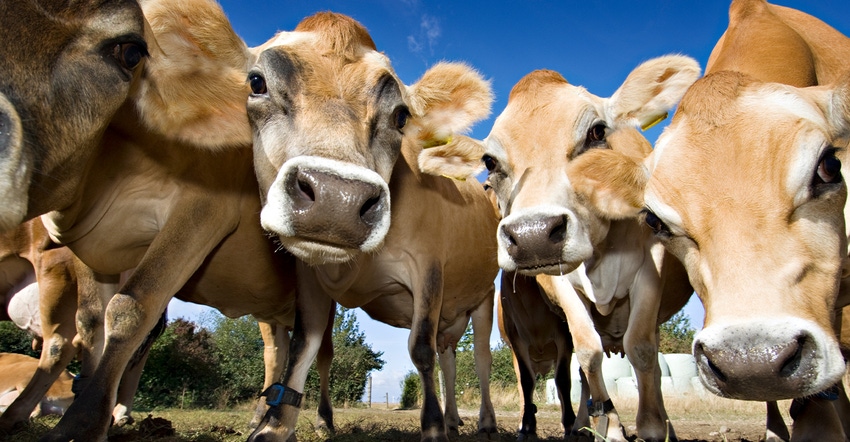
The Class III milk price has shown steady improvement since early in the year, says Bob Cropp, University of Wisconsin-Madison dairy economist. “Class III was a low of $13.89 in February and increased $3.66 by July to $17.55,” he says. “But with changes in dairy product prices August will see a smaller increase.”
USDA predicts Class III futures will peak in September at about $17.80 and then decline slightly during the fourth quarter and end in December at about $17. But Cropp disagrees. He thinks the Class III milk price will go higher than what USDA predicts.
Reasons price will go up
“Milk prices could do better than this for the fourth quarter for several reasons,” Cropp says. “Butter and cheese will be in the strong seasonal sales period Thanksgiving through the holidays. Schools will be starting [in September], increasing fluid milk sales, leaving less milk for dairy product production.”
Cropp believes milk production will show some seasonal strength but will remain below year-ago levels.
“Lower dairy exports have dampened the increase in milk prices some,” he says. “With lower milk production, exports don’t need to be as high to support prices.”
According to the U.S. Dairy Export Council, loss of exports to China due to retaliatory tariffs and African swine fever, plus strong competition from the European Union and New Zealand, resulted in exports for the first half of the year to be down 14% from last year.
“Cheese exports have been the bright spot, with exports 4% higher than a year ago for the first half of the year with record volumes to South Korea, Southeast Asia and Central America,” Cropp says.
But in June, cheese exports dropped by 12%. For the first half of the year, dry whey exports were 25% lower due almost entirely to exports to China being down 58%. On a total milk solids basis, U.S. exports were equivalent to 14.1% of U.S. milk solids production for the first half of the year compared to 16.7% a year ago, according to USDA.
USDA’s milk production report estimated July milk production to be down 0.2% from a year ago, the net result of almost 1% fewer milk cows and an increase in milk per cow of just 0.9%. Milk cow numbers continue to decline, dropping 9,000 head between June and July.
On the Chicago Mercantile Exchange, barrel cheese was as high as $1.78 per pound in July and $1.75 in mid-August. The 40-pound blocks were as high as $1.86 per pound in July and $1.90 in mid-August.
Butter will average lower in August. Butter was as high as $2.43 per pound in July and $2.33 in mid-August. Dry whey was 32 cents per pound in July and has improved to 37 cents. Nonfat dry milk was as high as $1.05 per pound in July but has decreased to $1.03. The little improvement in cheese and dry whey prices will put the August Class III price near $17.60.
Milk prices in 2020 will depend a lot on milk production. USDA is forecasting milk production to be 1.6% higher due to milk cow numbers averaging 0.2% higher and milk per cow 1.4% higher. But Cropp says this level of milk production could be on the higher side.
“There may be no increase in the number of milk cows,” Cropp notes. “Dairy cow slaughter continues to run higher than a year ago. Dairy herds exiting the industry continues to run relatively high. Financial stress for more than four years will hinder dairy expansions. The number of dairy replacements is lower, standing at 44.1 per 100 milk cows, the lowest since depressed milk prices in 2009.”
Lower feed quality
Feed quality is also a concern. Stocks of quality hay are tight, Cropp says. Corn and soybean meal prices will average higher. The result may lower the increase in milk per cow. There is also some concern as to whether the U.S. economy will slow and impact dairy product sales.
There is also concern that the world economy could slow, impacting dairy exports. USDA is still forecasting 2020 exports to be 5.3% higher on a milk fat basis than 2019, and 4.4% higher on a total milk solids basis.
“So, there is a lot that can sway milk prices higher or lower,” Cropp says. “Dairy futures are currently not overly optimistic about 2020 milk prices.
“Class III futures stay below $17 through July and only get to the low $17s the remainder of the year. USDA, likewise, is not overly optimistic as to how much higher milk prices will rise in 2020. USDA forecasts Class III to average $16.55, just 25 cents higher than the forecast for this year.
“But there still is a good probability milk prices could strengthen the last half of 2020 and end up averaging better than 2019,” Cropp says.
About the Author(s)
You May Also Like






